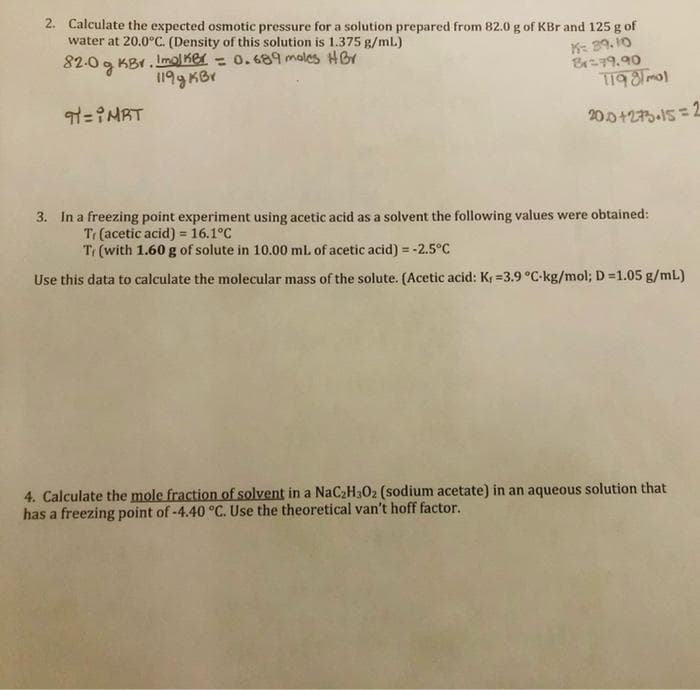3. In a freezing point experiment using acetic acid as a solvent the following values were obtained: Tr (acetic acid) = 16.1°C Tr (with 1.60 g of solute in 10.00 mL of acetic acid) = -2.5°C Use this data to calculate the molecular mass of the solute. (Acetic acid: Kr=3.9 °C-kg/mol; D=1.05 g/mL)
3. In a freezing point experiment using acetic acid as a solvent the following values were obtained: Tr (acetic acid) = 16.1°C Tr (with 1.60 g of solute in 10.00 mL of acetic acid) = -2.5°C Use this data to calculate the molecular mass of the solute. (Acetic acid: Kr=3.9 °C-kg/mol; D=1.05 g/mL)
Chemistry: Principles and Reactions
8th Edition
ISBN:9781305079373
Author:William L. Masterton, Cecile N. Hurley
Publisher:William L. Masterton, Cecile N. Hurley
Chapter10: Solutions
Section: Chapter Questions
Problem 68QAP: Consider two solutions at a certain temperature. Solution X has a nonelectrolyte as a solute and an...
Related questions
Question
3

Transcribed Image Text:2. Calculate the expected osmotic pressure for a solution prepared from 82.0 g of KBr and 125 g of
water at 20.0°C. (Density of this solution is 1.375 g/mL)
82.0 g KBv. Imolker = 0.689 moles HBr
119gKBr
K: 39.10
8=79.90
1198/mal
π = iMRT
200+273.15=2
3. In a freezing point experiment using acetic acid as a solvent the following values were obtained:
Tr (acetic acid) = 16.1°C
Tr (with 1.60 g of solute in 10.00 mL of acetic acid) = -2.5°C
Use this data to calculate the molecular mass of the solute. (Acetic acid: Kr=3.9 °C-kg/mol; D=1.05 g/mL)
4. Calculate the mole fraction of solvent in a NaC₂H302 (sodium acetate) in an aqueous solution that
has a freezing point of -4.40 °C. Use the theoretical van't hoff factor.
Expert Solution
This question has been solved!
Explore an expertly crafted, step-by-step solution for a thorough understanding of key concepts.
This is a popular solution!
Trending now
This is a popular solution!
Step by step
Solved in 2 steps with 2 images

Knowledge Booster
Learn more about
Need a deep-dive on the concept behind this application? Look no further. Learn more about this topic, chemistry and related others by exploring similar questions and additional content below.Recommended textbooks for you

Chemistry: Principles and Reactions
Chemistry
ISBN:
9781305079373
Author:
William L. Masterton, Cecile N. Hurley
Publisher:
Cengage Learning

Chemistry
Chemistry
ISBN:
9781305957404
Author:
Steven S. Zumdahl, Susan A. Zumdahl, Donald J. DeCoste
Publisher:
Cengage Learning


Chemistry: Principles and Reactions
Chemistry
ISBN:
9781305079373
Author:
William L. Masterton, Cecile N. Hurley
Publisher:
Cengage Learning

Chemistry
Chemistry
ISBN:
9781305957404
Author:
Steven S. Zumdahl, Susan A. Zumdahl, Donald J. DeCoste
Publisher:
Cengage Learning


Chemistry: An Atoms First Approach
Chemistry
ISBN:
9781305079243
Author:
Steven S. Zumdahl, Susan A. Zumdahl
Publisher:
Cengage Learning

Chemistry: The Molecular Science
Chemistry
ISBN:
9781285199047
Author:
John W. Moore, Conrad L. Stanitski
Publisher:
Cengage Learning

Chemistry: Principles and Practice
Chemistry
ISBN:
9780534420123
Author:
Daniel L. Reger, Scott R. Goode, David W. Ball, Edward Mercer
Publisher:
Cengage Learning